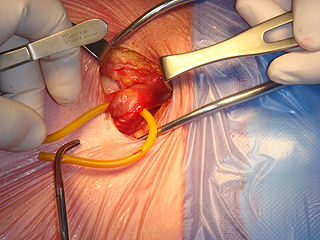Related Research Articles

Medicine is the science and practice of caring for a patient, managing the diagnosis, prognosis, prevention, treatment, palliation of their injury or disease, and promoting their health. Medicine encompasses a variety of health care practices evolved to maintain and restore health by the prevention and treatment of illness. Contemporary medicine applies biomedical sciences, biomedical research, genetics, and medical technology to diagnose, treat, and prevent injury and disease, typically through pharmaceuticals or surgery, but also through therapies as diverse as psychotherapy, external splints and traction, medical devices, biologics, and ionizing radiation, amongst others.

Surgery is a medical or dental specialty that uses operative manual and instrumental techniques on a person to investigate or treat a pathological condition such as a disease or injury, to help improve bodily function, appearance, or to repair unwanted ruptured areas.

An appendectomy, also termed appendicectomy, is a surgical operation in which the vermiform appendix is removed. Appendectomy is normally performed as an urgent or emergency procedure to treat complicated acute appendicitis.

A hiatal hernia is a type of hernia in which abdominal organs slip through the diaphragm into the middle compartment of the chest. This may result in gastroesophageal reflux disease (GERD) or laryngopharyngeal reflux (LPR) with symptoms such as a taste of acid in the back of the mouth or heartburn. Other symptoms may include trouble swallowing and chest pains. Complications may include iron deficiency anemia, volvulus, or bowel obstruction.

The Johns Hopkins Hospital (JHH) is the teaching hospital and biomedical research facility of the Johns Hopkins School of Medicine, located in Baltimore, Maryland, U.S. It was founded in 1889 using money from a bequest of over $7 million by city merchant, banker/financier, civic leader and philanthropist Johns Hopkins (1795–1873). Johns Hopkins Hospital and its school of medicine are considered to be the founding institutions of modern American medicine and the birthplace of numerous famous medical traditions including rounds, residents and house staff. Many medical specialties were formed at the hospital including neurosurgery, by Harvey Cushing and Walter Dandy; cardiac surgery by Alfred Blalock; and child psychiatry, by Leo Kanner. Attached to the hospital is the Johns Hopkins Children’s Center which serves infants, children, teens, and young adults aged 0–21.
Bloodstream infections (BSIs), which include bacteremias when the infections are bacterial and fungemias when the infections are fungal, are infections present in the blood. Blood is normally a sterile environment, so the detection of microbes in the blood is always abnormal. A bloodstream infection is different from sepsis, which is the host response to bacteria.

Harrison's Principles of Internal Medicine is an American textbook of internal medicine. First published in 1950, it is in its 20th edition and comes in two volumes. Although it is aimed at all members of the medical profession, it is mainly used by internists and junior doctors in this field, as well as medical students. It is widely regarded as one of the most authoritative books on internal medicine and has been described as the "most recognized book in all of medicine."
Aortic valve replacement is a procedure whereby the failing aortic valve of a patient's heart is replaced with an artificial heart valve. The aortic valve may need to be replaced because:

In medicine, aortoiliac occlusive disease, is a form of central artery disease involving the blockage of the abdominal aorta as it transitions into the common iliac arteries.

A cystic hygroma is an abnormal growth that usually appears on a baby's neck or head. It consists of one or more cysts and tends to grow larger over time. The disorder usually develops while the fetus is still in the uterus but can also appear after birth.
Fever of unknown origin (FUO), refers to a condition in which the patient has an elevated temperature (fever) but despite investigations by a physician no explanation has been found.

The Duke University School of Medicine, commonly known as Duke Med, is the medical school of Duke University. It is located in the Collegiate Gothic-style West Campus of Duke University in Durham, North Carolina. The School of Medicine, along with the Duke University School of Nursing, Duke University Hospital, Duke Regional Hospital, Duke Children's Hospital, Duke Raleigh Hospital, and other affiliated hospitals, clinics, and laboratories, make up the Duke University Health System. Established in 1925 by James B. Duke, the School of Medicine has earned its reputation as an integral part of one of the world's foremost patient care and biomedical research institutions.
A stress ulcer is a single or multiple mucosal defect which can become complicated by upper gastrointestinal bleeding or physiologic stress. Ordinary peptic ulcers are found commonly in the gastric antrum and the duodenum whereas stress ulcers are found commonly in fundic mucosa and can be located anywhere within the stomach and proximal duodenum.

Pulmonaryinsufficiency is a condition in which the pulmonary valve is incompetent and allows backflow from the pulmonary artery to the right ventricle of the heart during diastole. While a small amount of backflow may occur ordinarily, it is usually only shown on an echocardiogram and is harmless. More pronounced regurgitation that is noticed through a routine physical examination is a medical sign of disease and warrants further investigation. If it is secondary to pulmonary hypertension it is referred to as a Graham Steell murmur.
George Thomas Shires was an American trauma surgeon. He is known for his research on shock, which initiated the current practice of giving saline to trauma and surgical patients. He operated on John Connally and Lee Harvey Oswald after the assassination of John F. Kennedy.
Cardiothoracic anesthesiology is a subspeciality of the medical practice of anesthesiology, devoted to the preoperative, intraoperative, and postoperative care of adult and pediatric patients undergoing cardiothoracic surgery and related invasive procedures.

Inguinal hernia surgery is an operation to repair a weakness in the abdominal wall that abnormally allows abdominal contents to slip into a narrow tube called the inguinal canal in the groin region.
Seymour I. Schwartz, was the Distinguished Alumni Professor for the Department of Surgery at the University of Rochester in Rochester, New York. He was one of the most prolific and honored surgeons in American history with further successes outside of the field of medicine as a renowned author and cartographic historian. His most notable accomplishments in surgery include being the founding Editor-in-Chief of Schwartz's Principles of Surgery, Chairman of the Department of Surgery at the University of Rochester (1987-1998), Editor-in-Chief of the Journal of the American College of Surgeons (1996-2004) and President of the American College of Surgeons (1997-1998). After spending nearly 65 years in the field of surgery, he has published hundreds of research articles, textbook chapters, and received numerous honors in the United States and abroad. Schwartz has lectured throughout the world as a visiting professor and donated to many philanthropic endeavors. His influence on surgical education and leadership has impacted nearly every practicing surgeon in the world. Throughout his career, Schwartz has treated and changed the lives of tens of thousands of patients and trained generations of residents and fellows to share in his legacy and do the same.

Pradeep Kumar Chowbey is an Indian surgeon, known for laparoscopic and bariatric surgeries. He is the incumbent Executive vice chairman of the Max Healthcare, Chairman of the Minimal Access, Metabolic & Bariatric Surgery and Allied Surgical Specialities of the Max Healthcare Institute, New Delhi. He is the founder of the Minimal Access, Metabolic & Bariatric Surgery Centre at the Sir Ganga Ram Hospital, New Delhi and has served as the Honorary Surgeon to the President of India, Dalai Lama and the Indian Armed Forces (AFMS). The Government of India awarded him the fourth highest civilian honour of the Padma Shri in 2002.
Anne Louise Rosenberg is an American surgical oncologist retired from practice in Cherry Hill, New Jersey.
References
- ↑ "Second Foreword". Schwartz's Principles of Surgery. McGraw-Hill Education. 2019.
- ↑ "Schwartz's Principles of Surgery, 11e | AccessMedicine | McGraw Hill Medical".
- ↑ Charles Brunicardi, F. (February 2019). Schwartz's Principles of Surgery. ISBN 978-1259835353.